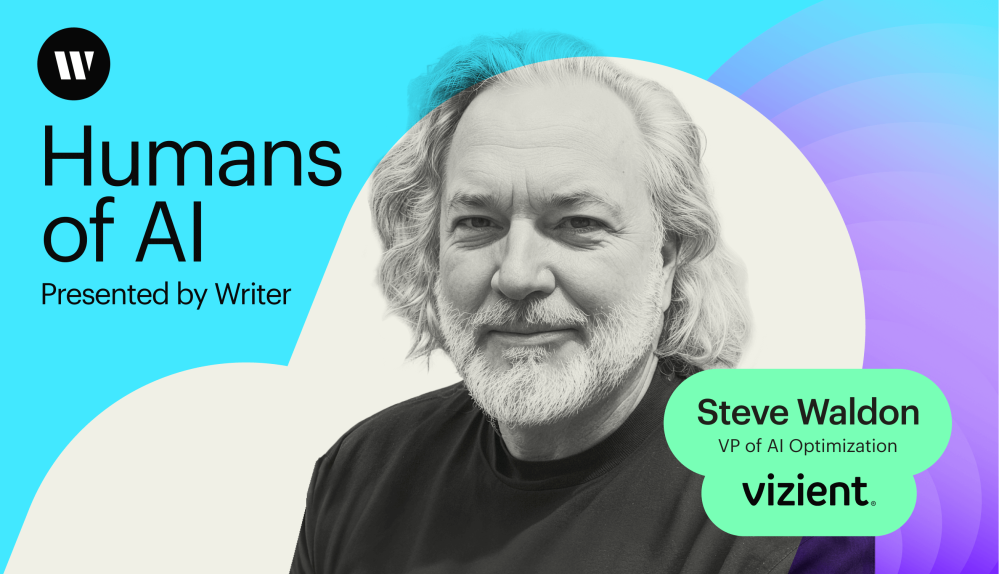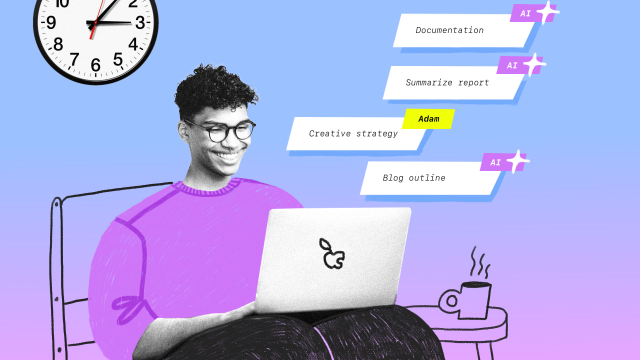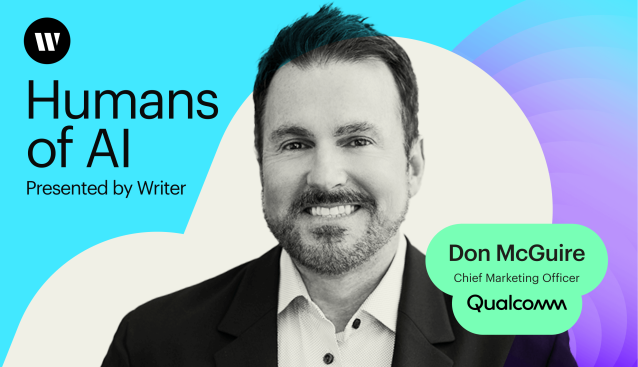Humans in the loop
– 8 min read
The “Iron Man suit” of AI and human creativity
A 40-year perspective from Vizient’s Steve Waldon

Scientific breakthroughs from originals like Grace Hopper and Alan Turing sparked a mid-20th-century science fiction renaissance. Movies like Blade Runner didn’t just mirror our technological dreams and anxieties, but shaped them. So, where do we stand with generative AI today? And can technology ever evolve to a stage where it can create its own paradigm shift?
In our first episode of season two of Humans of AI, we have a conversation with Steve Waldon. Steve is the Senior Vice President of AI Optimization at Vizient, a Fortune 100 healthcare performance company. Steve’s career — from early experiments with self-driving cars to leading AI optimization in healthcare — shows just how far the landscape of AI has evolved in recent decades.
Join us as he shares his insights on the evolution of AI, the critical role of human creativity in innovation, and his ongoing efforts to democratize innovation across Vizient.
- Initially skeptical about AI’s practical applications, Steve now recognizes its potential in augmenting human creativity and productivity.
- Steve stresses the importance of human creativity and the unique ability of humans to create new ideas. He believes that while AI can help in improving and putting these ideas into action, it can’t yet make the kind of creative breakthroughs that define human innovation.
- At Vizient, Steve has been instrumental in democratizing innovation through generative AI, enabling non-software engineers to create custom solutions.
- Steve developed a unique approach at Vizient that uses champions to foster acceptance and inspire innovative uses of AI among employees.
From self-driving cars to AI optimization
Steve’s journey into the world of AI began not with algorithms and data sets, but with a dusty dune buggy fixed with balloon tires at Drexel University. Back in 1985, this wasn’t just any buggy — it was the bedrock of a self-driving car project, funded by the army.
The excitement of pioneering early autonomous vehicles was palpable, yet it was tempered by the technological limitations of the era. What Steve remembers most is the potential and the vibrant discussions.
“This was a lab of like ten people that was really thinking about intelligence and whether this is possible and what’s possible, and it was probably one of the most creative times ever in my life, really. And then it kind of led me in a really interesting direction,” Steve explains.
Fast forward to today, Steve is the Senior Vice President of AI Optimization at Vizient, a Fortune 100 healthcare performance company. In this role, he’s focused on changing the way over 4,000 employees work by integrating AI into their daily operations.
The harsh reality of AI limitations
Steve’s path to Vizient wasn’t so straightforward, though. Steve was enamored by AI, excited about autonomous vehicles in the ‘80s and ‘90s, but not sold on the technology’s trajectory.
So, he left the field.
Steve returned to academia, pursuing further studies in computer science with a focus on human perception and computer vision. This was a field that promised to bridge the gap between human senses and machine capabilities.
This phase of Steve’s career was marked by a blend of optimism and, again, the harsh realities of technological limitations.
“We had really cool, advanced computers at that time for processing images, but they were nowhere near what we could do. It felt like we were playing with toys,” he explains. “Machine vision started working a little bit, but it was really always very constrained and you really had to tweak it for a very special situation. Everything really only worked in toy worlds.”
A toy world is a computer simulation that’s entirely structured. Think of it as a sandbox where theoretical concepts play out.
Even though Steve wasn’t impressed by the technology at the time, it was these very toy worlds that laid the building blocks for the AI we use today. And pushed him to think even deeper about how AI relates to human creativity.
Links between cultural and biological evolution
Steve has been pondering the elusive nature of human creativity for 40-plus years. Specifically, the ability to conjure groundbreaking, original ideas from thin air, a feat that AI systems struggle to replicate.
“What is it that’s special about creativity?” Steve ponders. “That opened up beyond just human creativity to the creativity of the natural world and the fact that there’s a lot of similarities in the structures that evolution created.”
Both human cultural evolution and biological evolution are marked by groundbreaking shifts that usher in new periods of growth and diversity. Take the Cambrian explosion, for example. Environmental and genetic shifts around 541 million years ago led to an explosion of life forms. Even though it seemed like they were radical diversions, they were just variations of the same thing.
The same can be said about human culture — individual human beings introduce an original idea that inspires masses of human beings to apply that idea in new ways, ushering in a new era of society. Just like how key figures such as Edison and Tesla sparked the electric age, or how Thomas Kuhn’s scientific revolutions reshaped societal paradigms.
When you’re taking an idea and you’re driving other ideas from it, or you’re evolving it, it’s a different level of creativity. AI can add on to ideas creatively, but it doesn’t have the ability to mimic this pattern we see in biological and cultural evolution.
“For instance, there’s a lot of creative stuff that goes into writing pop songs within a given genre. Now we’re seeing that actually can be done on a fair bit by a machine once you’ve got it defined,” Steve explains. “But defining a new genre, that’s where there’s like another level of creativity.”
An algorithm for creativity
Will AI ever be able to reach this level of creativity? Is there a general algorithm humans can create for creativity?
For Steve, so far the answer is no.
“I don’t think there’s an algorithm that does this stuff. I think there’ll be algorithms to do almost everything that we do,” Steve says. “We will be able to create robots to work in factories. We’ll be able to ride cars that drive around, but I don’t think we’ll have an algorithm for the part that can create.”
Generative AI can create variations on original themes sourced from human creativity. AI models can learn from our paradigm. But they can’t be expected to bring in a worldview different from the only one they’ve ever known. The systems would need to develop a theory of mind to create an original catalyst.
Originality and breakthroughs are what separate life forms from AI. Generative AI isn’t going to come up with new, big ideas for you — but it can help contextualize and refine those ideas.
“Basically the big ideas, they’re not the everyday work of most people,” Steve explains. “Most people are working on filling in and implying those ideas, and I think that’s where you don’t need to be human to do that part necessarily. That can be more robotic.”
AI as a superpower for the masses
AI functions best as a collaborative partner, or a “co-intelligence” as one of Steve’s coworkers calls it. At Vizient, Steve and his team have developed an approach where they take champions from different workforces and have them don “the Iron Man suit” of AI.
“They would then provide the inspiration for everyone else on what it could be like. It turned out to be a super positive thing, everybody was clamoring for the technology,” Steve says. “When you put on the suit. It’s essentially co-intelligence. You’ve learned to think in prompts. That has proved to be really instrumental in a positive engagement with the technology.”
AI isn’t coming for people’s jobs — it’s making workers more productive and engaged.
“We want to grow the business, right? If you’re thinking, ‘I’m gonna use less people,’ then you’re thinking, ‘I’m not thinking about growing my business right now,’” he says. “We’re much more in the place of people being able to just be a much better version of themselves at work.”
A recent hackathon at Vizient revealed just how important it is to democratize innovation in an organization, and how generative AI is making that possible.
Half the people in the hackathon were from various parts of the business. The winner of the hackathon wasn’t even a software engineer.
“I was like, ‘Oh wow, this is really a paradigm shift.’ It’s kind of this notion that I can build the tool for myself without having to go commission a team of software engineers to build this use case,” Steve says.”It’s enabled a whole group of people who would never have been able to build custom solutions for themselves.”
Originals like Steve are bringing a paradigm shift to organizations around the world — helping people put on the Iron Man suits of AI, helping them discover the power of co-intelligence to bring out their full potential, putting tools in their hands to bring original ideas to life in ways they never could have previously.
So the question is: Are you ready for the Cambrian explosion of ideas and innovation that generative AI will enable?
Want to hear more stories from the humans working at the crossroads of business and generative AI? Subscribe to Humans of AI wherever you listen to podcasts.



